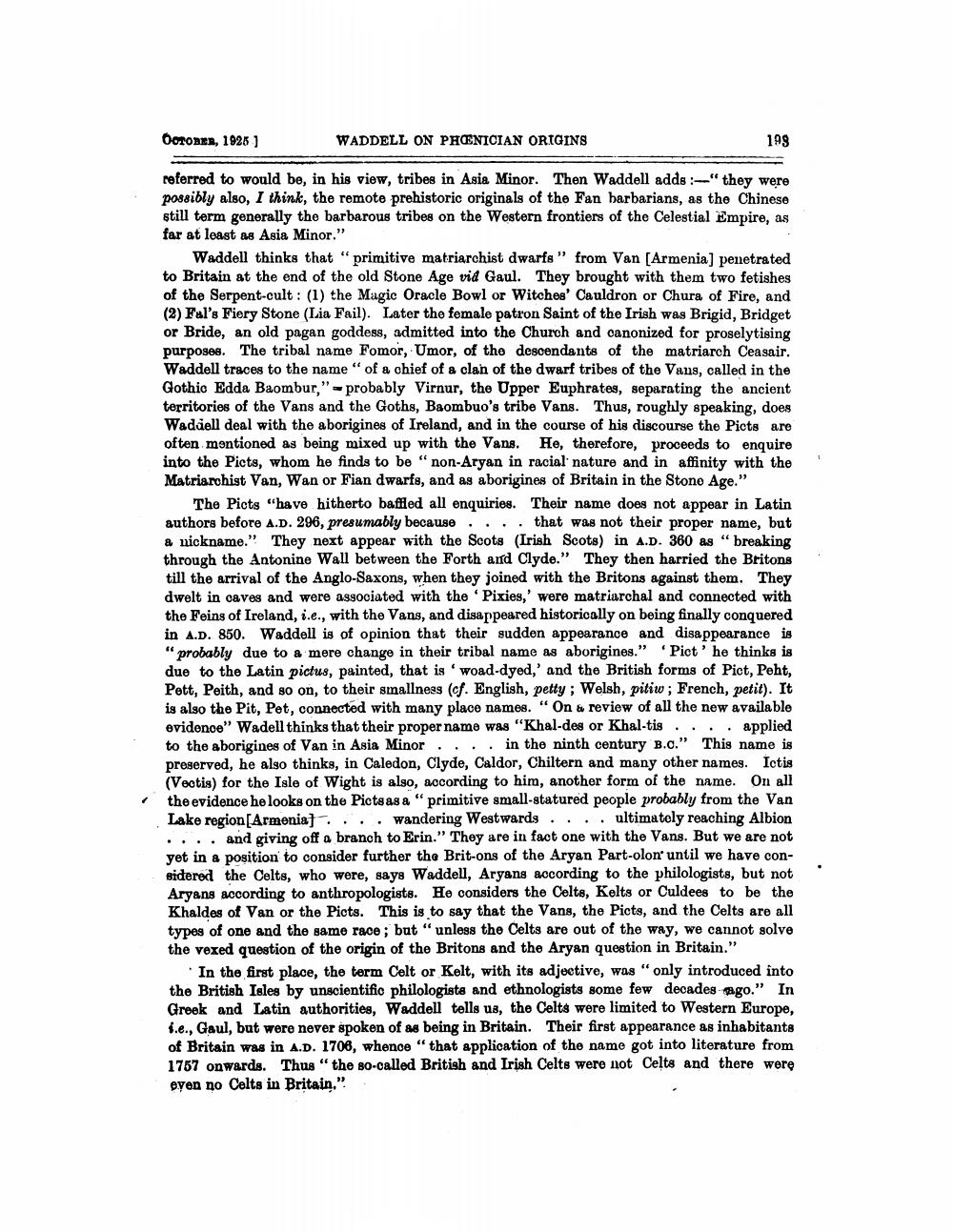________________
OOTORER, 1926 )
WADDELL ON PHOENICIAN ORIGINS
198
referred to would be, in his view, tribes in Asia Minor. Then Waddell adds :-"they were possibly also, I think, the remote prehistoric originals of the Fan barbarians, as the Chinese still term generally the barbarous tribes on the Western frontiers of the Celestial Empire, as far at least as Asia Minor."
Waddell thinks that "primitive matriarchist dwarfs" from Van (Armenia) penetrated to Britain at the end of the old Stone Age vid Gaul. They brought with them two fetishes of the Serpent-cult: (1) the Magic Oracle Bowl or Witches' Cauldron or Chura of Fire, and (2) Fal's Fiery Stone (Lia Fail). Later the female patron Saint of the Irish was Brigid, Bridget or Bride, an old pagan goddess, admitted into the Church and canonized for proselytising purposes. The tribal name Fomor, Umor, of the descendants of the matriarch Ceasair. Waddell traces to the name " of a chief of a clan of the dwarf tribes of the Vang, called in the Gothic Edda Baombur," - probably Virnur, the Upper Euphrates, separating the ancient territories of the Vans and the Goths, Baombuo's tribe Vans. Thus, roughly speaking, does Waddell deal with the aborigines of Ireland, and in the course of his discourse the Picts are often mentioned as being mixed up with the Vang. He, therefore, proceeds to enquire into the Picts, whom he finds to be "non-Aryan in racial nature and in affinity with the Matriarchist Van, Wan or Fian dwarfs, and as aborigines of Britain in the Stone Age."
The Picts have hitherto bafiled all enquiries. Their name does not appear in Latin authors before A.D. 296, presumably because .... that was not their proper name, but a nickname." They next appear with the Scots (Irish Scots) in A.D. 360 as "breaking through the Antonine Wall between the Forth and Clyde." They then harried the Britons till the arrival of the Anglo-Saxons, when they joined with the Britons against them. They dwelt in caves and were associated with the 'Pixies,' were matriarchal and connected with the Feins of Ireland, i.e., with the Vans, and disappeared historically on being finally conquered in A.D. 850. Waddell is of opinion that their sudden appearance and disappearance is "probably due to a mere change in their tribal name as aborigines." Pict' he thinks is due to the Latin pictus, painted, that is 'woad-dyed,' and the British forms of Pict, Peht, Pett, Peith, and so on, to their smallness (cf. English, petty; Welsh, pitiw; French, petit). It is also the Pit, Pet, connected with many place names. "On a review of all the new available evidence" Wadell thinks that their proper name was "Khal-des or Khal-tis.... applied to the aborigines of Van in Asia Minor.... in the ninth century B.C." This name is preserved, he also thinks, in Caledon, Clyde, Caldor, Chiltern and many other names. Ictis (Veotis) for the Isle of Wight is also, according to him, another form of the name. On all the evidence he looks on the Picts as a "primitive small-statured people probably from the Van Lake region [Armenia) ..wandering Westwards.... ultimately reaching Albion .... and giving off a branch to Erin." They are in fact one with the Vans. But we are not yet in a position to consider further the Brit-ons of the Aryan Part-olon until we have considered the Celts, who were, says Waddell, Aryans according to the philologists, but not Aryans according to anthropologists. He considers the Celts, Kelts or Culdees to be the Khaldes of Van or the Picts. This is to say that the Vans, the Picts, and the Celts are all types of one and the same race; but "unless the Celts are out of the way, we cannot solve the vexed question of the origin of the Britons and the Aryan question in Britain."
In the first place, the term Celt or Kelt, with its adjective, was "only introduced into the British Isles by unscientific philologists and ethnologists some few decades ago." In Greek and Latin authorities, Waddell tells us, the Celts were limited to Western Europe, 1.e., Gaul, but were never spoken of as being in Britain. Their first appearance as inhabitants of Britain was in A.D. 1706, whenoe" that application of the name got into literature from 1757 onwards. Thus "the so-called British and Irish Celts were not Celts and there were eyen no Celts in Britain,"




